苯甲醛是有机合成的重要中间体, 广泛用于医药、染料、香料等行业.其合成方法主要有:苯乙烯氧化法、甲苯氧化法、苯甲酸还原法、苯甲醇氧化法.其中, 苯甲醇选择氧化法工艺简单、环境友好, 有良好的应用前景[1-8].苯甲醇氧化催化剂主要有:负载型贵金属、杂多酸、过渡金属催化剂等.其中负载型杂多酸催化剂, 在液相氧化反应中易发生溶脱, 实际应用受到限制.近年来, 以Co、Mn、Cu为活性组分的非贵金属催化剂[2-6]报道居多.例如, Ragupathi等[2-3]制备了CuAl2O4和CoAl2O4催化剂, 用于苯甲醇氧化反应, 氧化剂为H2O2, 溶剂为乙腈, 80 ℃反应苯甲醇转化率较高. Tang等[7-8]用浸渍法制备了K-Mn/Al2O3催化剂, 用于苯甲醇氧化反应, 氧化剂为O2, 催化剂重复使用5次, 苯甲醇转化率达71.4%.
近年来, 一种新型材料—金属有机骨架化合物(MOF)受到了广泛关注. MOF是由过渡金属离子和多齿有机配体形成的配合物, 有较高的孔隙率、巨大的表面积和功能化的不饱和位点, 在气体吸附、分离、催化等方面得到应用[9-11]. Cu-BTC, 也称为HKUST-1, 是一种典型的MOF材料.任蕾等[12]用溶剂热方法制备Cu-BTC, 用于苯甲醇-H2O2氧化反应, 乙腈作溶剂, 60 ℃反应, 苯甲醇转化率30.7%. Cu-BTC是一种金属-有机配合物, 其催化苯甲醇氧化反应遵循“配位催化”机理:反应过程中, 苯甲醇分子充当一种有机配体, 键合在Cu-BTC的不饱和金属位点而活化.
文献报道:在空气中焙烧Cu-BTC, 可制得衍生物Cu2O或CuO; 在氮气中焙烧Cu-BTC, 也可制得其衍生物, 还保留了碳组分[13-15].目前, Cu-BTC衍生物催化苯甲醇氧化反应, 尚无文献报道.
我们以硝酸铜和均苯三甲酸为原料, 水热法合成了Cu-BTC.在N2中焙烧Cu-BTC制得其衍生物Cu@C.以双氧水(H2O2)为氧化剂, 用于水相条件下催化苯甲醇选择氧化(水为溶剂的绿色合成反应), 并分析了影响催化剂活性稳定性的原因.
1 实验部分 1.1 催化剂制备将1.087 g Cu(NO3)2·3H2O溶于15 mL去离子水, 0.525 g均苯三甲酸溶于15 mL乙醇, 超声处理10 min.将两种溶液均匀混合, 转移到100 mL配有聚四氟乙烯内衬的高压釜中, 升温至设定温度(100、110或120 ℃), 晶化一段时间(12、24或48 h).然后, 冷却至室温, 将获得的蓝色晶体用水-乙醇混合液(体积比1:1) 多次洗涤. 110 ℃干燥12 h, 100 ℃减压干燥6 h, 制得Cu-BTC.如: Cu-BTC(110C/24 h)表示110 ℃晶化24 h制得的Cu-BTC.
取2 g Cu-BTC(110C/24 h)样品置于N2中, 流量30 mL/min, 以10 ℃/min的速率升温至500、600或700 ℃, 各恒温处理2 h, 得到Cu-BTC衍生物.如: Cu@C(N2, 500C)表示N2气氛中500 ℃焙烧制得的Cu-BTC衍生物.
1.2 催化剂表征 1.2.1 物相分析(XRD)测试仪器为日本岛津XRD-6100型X射线衍射仪, CuKα射线(λ=0.154 nm), 石墨单色器, 管压40 kV, 管流30 mA, 闪烁计数器记录衍射强度.用Scherrer方程计算晶粒尺寸.
1.2.2 红外光谱(FTIR)测试仪器为日本岛津FTIR-8400s红外光谱仪, KBr压片.
1.2.3 N2物理吸附(BET)测试仪器为美国Quantachrome公司生产的NOVA3000型自动吸附仪.测试前, 样品先经150 ℃减压处理2 h, 除去表面吸附的杂质. N2为吸附气, 液氮温度下吸附, 室温脱附, 用BET公式计算比表面积.
1.2.4 热分析(TG-DSC)测试仪器为德国耐驰STA409PC型同步热分析仪, 样品用量4 mg, 以10 ℃/min的速率升温至800 ℃, N2气氛, 流量30 mL/min.
1.2.5 能量色散X射线光谱(EDX)测试仪器为日本日立S-4800型电镜附带Horiba EX-350型能谱仪, 对Cu@C样品进行分析.
1.3 催化反应将装有1 mL苯甲醇、10 mL水、0.05 g催化剂的50 mL三口烧瓶放入油浴锅中, 磁力搅拌, 并加热至70 ℃.滴入4 mL质量浓度为30%的双氧水, 反应1 h.之后, 加入10 mL甲苯进行萃取, 用吸管吸取上层液体, 放于离心管中, 用高速离心机进行分离, 再用针式过滤器(孔径0.45 μm)过滤, 得到分析试样.用日本岛津GC-2010Plus型气相色谱仪检测各组分的含量, 进样量0.5 uL.测试条件: Wax毛细管柱, FID检测器, 汽化温度260 ℃, 柱温180 ℃.根据各组分含量, 计算苯甲醇转化率和苯甲醛选择性.
2 结果与讨论 2.1 Cu-BTC的结构表征图 1、图 2是不同晶化条件制备Cu-BTC的XRD谱图.各样品均出现了金属有机骨架化合物Cu-BTC的(200)、(220)、(222)、(400)、(440) 等晶面的特征衍射峰[16].根据Scherrer方程, 计算得到Cu-BTC(100C/24 h)、Cu-BTC(110C/24 h)、Cu-BTC(120C/24 h)的晶粒尺寸分别为38.4、21.1、40.6 nm, 而Cu-BTC(110C/12 h)、Cu-BTC(110C/24 h)、Cu-BTC(110C/48 h)的晶粒分别为26.0、21.1、59.6 nm.可见, 110 ℃晶化24 h得到的Cu-BTC晶粒较小, 测得其比表面积高达1 047.9 m2/g.

|
图 1 不同晶化温度制备Cu-BTC的XRD谱图 Figure 1 XRD patterns of Cu-BTC prepared at different crystallization temperature |
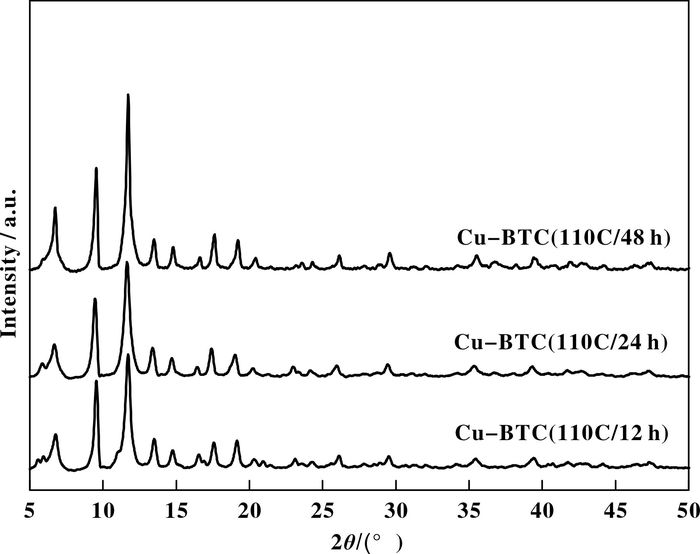
|
图 2 110 ℃晶化不同时间制备Cu-BTC的XRD谱图 Figure 2 XRD patterns of Cu-BTC prepared at 110 ℃ with different crystallization time |
图 3、图 4给出了Cu-BTC的FTIR光谱.其中760和730 cm-1处的IR峰归属C—H键的弯曲振动, 1 630和1 560 cm-1为羧酸基团(-COO-)的不对称伸缩振动峰, 1 444和1 371 cm-1为其对称伸缩振动峰.与纯BTC的IR光谱(未列出)对比发现, Cu2+与BTC之间的配位反应还生成了新的官能团[16-17].

|
图 3 不同晶化温度制备Cu-BTC的FTIR谱图 Figure 3 FTIR spectra of Cu-BTC prepared at different crystallization temperature |
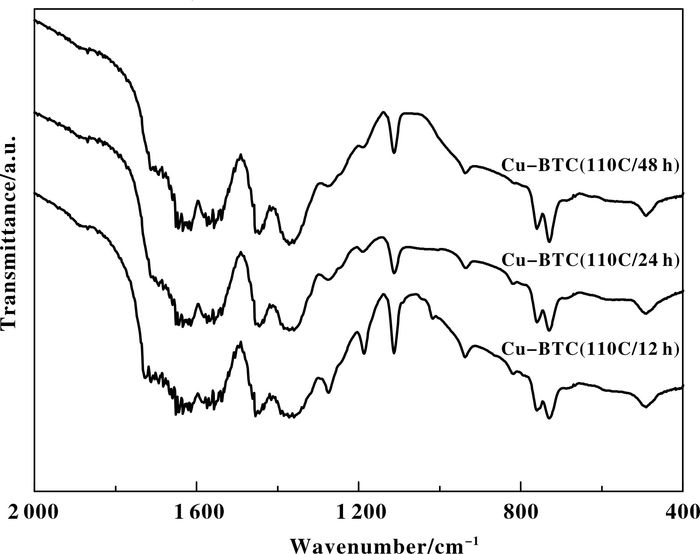
|
图 4 110 ℃晶化不同时间制备Cu-BTC的FTIR谱图 Figure 4 FTIR spectra of Cu-BTC prepared at 110 ℃ with different crystallization time |
表 1、表 2列出了不同条件晶化Cu-BTC催化剂的活性数据, 对比而言, 110 ℃晶化24 h制备Cu-BTC的活性较高, 苯甲醇转化率75.4%、苯甲醛选择性83.5%(余为苯甲酸). 图 5给出了反应前后Cu-BTC的XRD图谱.可以看出, 经过一次反应, Cu-BTC的特征衍射峰已消失, 其骨架结构破坏. Cu-BTC催化苯甲醇氧化反应遵循配位催化机理, 即苯甲醇分子充当配体, 键合在Cu-BTC的不饱和金属位点而活化.在水为溶剂的反应中, 水分子替代部分BTC分子而占据了Cu-BTC的活性位点, 从而弱化Cu2+与BTC分子之间的相互作用, 导致Cu-BTC结构解离.
| 表 1 不同晶化温度制备Cu-BTC的催化活性 Table 1 Catalytic activity of Cu-BTC prepared at different crystallization temperatures |
| 表 2 不同晶化时间制备Cu-BTC的催化活性 Table 2 Catalytic activity of Cu-BTC prepared with different crystallization time |

|
图 5 Cu-BTC(110C/24 h)反应前后的XRD谱图 Figure 5 XRD patterns of Cu-BTC(110C/24 h) before and after reaction |
图 6给出了氮气中Cu-BTC(110C/24 h)样品的热分析曲线.第一阶段失重在180 ℃之前, 为物理吸附水的脱除, 是一个吸热过程.第二阶段失重发生在180~320 ℃, 归属于Cu-BTC化学吸附水和乙醇的脱除, 是吸热过程.第三阶段失重在320~400 ℃区间, 为Cu-BTC有机配体的分解和碳化所致[18-19], 是强放热过程.
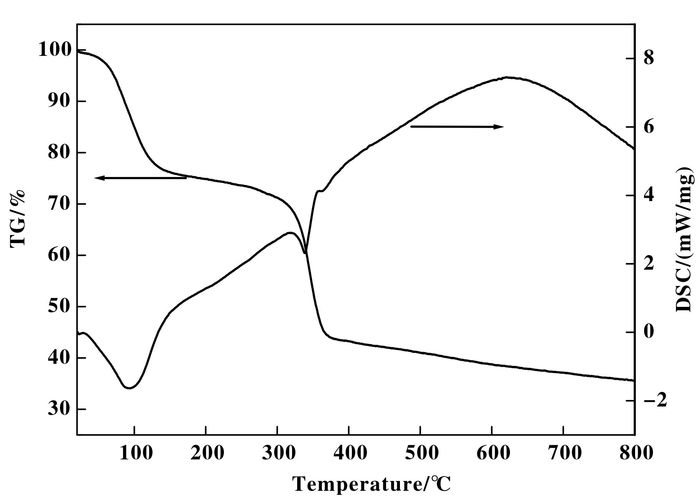
|
图 6 Cu-BTC(110C/24 h)在氮气中的热分析曲线 Figure 6 TG-DSC plots of Cu-BTC(110C/24 h) under nitrogen atmosphere |
图 7是Cu-BTC衍生物的XRD图谱, 可见: N2中500、600和700 ℃处理Cu-BTC, Cu2+均被有机跑配体还原成Cu0. Scherrer方程计算结果: Cu@C(N2, 500C)、Cu@C(N2, 600C)、Cu@C(N2, 700C)的Cu0晶粒尺寸分别为26.3、24.5、33.9 nm.

|
图 7 Cu-BTC衍生物Cu@C的XRD谱图 Figure 7 XRD patterns of Cu@C as the derivatives of Cu-BTC |
表 3列出了Cu@C催化剂的活性数据.可见随着Cu-BTC热处理温度的升高, 其衍生物Cu@C的催化活性有降低趋势, 这与Cu@C(N2, 700C)的Cu0晶粒较大有关.可喜的是, Cu@C(N2, 700C)上的苯甲醛选择性高于其他两个催化剂.
| 表 3 Cu-BTC衍生物Cu@C的催化活性 Table 3 Catalytic activity of Cu@C as the derivatives of Cu-BTC |
EDX测试表明: Cu@C(N2, 700C)中铜含量为61.9%(质量百分数), 其余为碳元素.测得Cu@C(N2, 700C)的比表面积为174.6 m2/g, 较高的表面积主要来自碳材料的贡献, 碳对活性组分起到了支撑和分散作用.下面实验考察该催化剂的重复使用活性.
2.4 Cu@C(N2, 700C)催化剂的重复使用实验表明: Cu@C(N2, 700C)上的苯甲醇转化率为57.8%, 第二次反应的苯甲醇转化率降至17%, 继续增加反应次数, 催化剂活性持续降低. 图 8给出了反应后Cu@C(N2, 700C)的XRD谱图.可以看出, 随着反应次数的增加, 催化剂中Cu2O物相的衍射峰越来越强, 且在2θ=23°附近出现了类草酸铜的新相, 这是由于Cu@C中的Cu0被氧化, 与反应体系中的有机相反应生成的.

|
图 8 反应后Cu@C(N2, 700C)的XRD谱图 Figure 8 XRD patterns of Cu@C(N2, 700C) catalyst after reaction |
为此, 我们将每次反应后的Cu@C(N2, 700C)催化剂均置于N2中300 ℃处理1 h, 发现草酸铜物相消失, Cu2O衍射峰也有所减弱(图 9), 这说明草酸铜发生了分解, 而具有还原性的草酸又与Cu2O的减少有关.并且, 每次反应后Cu@C(N2, 700C)表面吸附了各种有机物, 经氮气300 ℃处理, 这些有机物将发生脱附.因而, 经N2再生处理的Cu@C(N2, 700C)重复使用(每次反应3 h), 苯甲醇转化率基本不变(约60%), 见图 10.
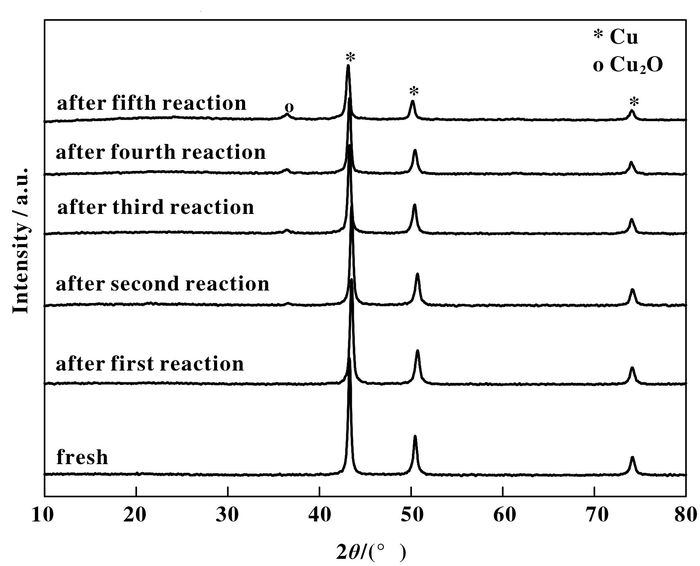
|
图 9 反应后Cu@C(N2, 700C)催化剂经N2-300 ℃处理的XRD谱图 Figure 9 XRD patterns of Cu@C catalysts after reaction and post-treatment in N2 at 300 ℃ |
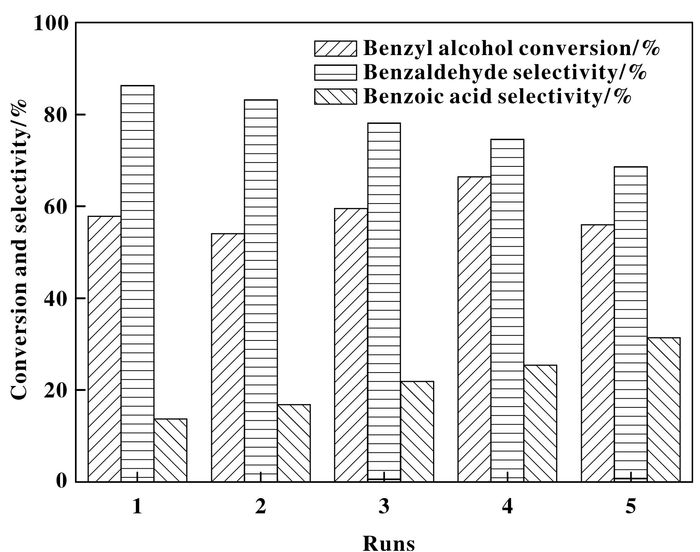
|
图 10 Cu@C(N2, 700C)的重复使用活性 Figure 10 The re-usable activity of Cu@C(N2, 700C) catalysts |
从图 10还可以看出, 随着反应次数的增加, Cu@C(N2, 700C)催化剂中Cu2O逐渐增多, Cu2O可促进苯甲醛的进一步氧化, 导致苯甲酸逐渐增多. Cu@C催化苯甲醇-H2O2氧化反应遵循氧化-还原机理(Redox): Cu0先吸附活化H2O2生成Cu2O, 接下来, Cu2O促使苯甲醇脱氢生成苯甲醛.部分Cu2O留在反应后的催化剂中, 是H2O2活化生成的活性氧与Cu0之间的强相互作用所致.为此, 以后的工作中, 我们计划在Cu@C表面添加适量的电子助剂(如: K2O), 以弱化Cu-O间的相互作用, 加快活性氧的脱除和催化剂中Cu0组分的再生, 提高苯甲醛的选择性.
3 结论 3.1水热合成了一种金属有机骨架化合物Cu-BTC, 用于催化苯甲醇氧化反应.优化了Cu-BTC的晶化条件. 70 ℃反应, Cu-BTC催化剂上的苯甲醇转化率75.4%、苯甲醛选择性83.5%, 反应后Cu-BTC骨架完全塌陷.
3.2在氮气中焙烧Cu-BTC, 制得衍生物Cu@C.催化剂重复使用5次, 可维持苯甲醇的较高转化率, 但苯甲醛选择性有所下降, 这可能因为Cu@C在反应中生成的Cu2O促进了苯甲醛的深度氧化.
| [1] |
a. Liu Cheng(刘成), Tan Rong(谭蓉), Yin Dong-hong(银董红), et al. Selective oxidation of benzyl alcohol catalyzed Pd/PMO-SBA-15 catalyst(Pd/PMO-SBA-15催化剂催化苯甲醇选择氧化反应性能)[J]. J Mol Catal(China)(分子催化), 2010, 31(11): 1369-1373. b. Zhang Cheng-ming(张成明), Sun Kun-peng(孙鲲鹏), Xu Xian-lun(徐贤伦). Preparation of CuMn-containing hydrotalcites and it's solvent-free catalytic oxidation of benzyl alcohol(含铜锰水滑石的制备及其对苯甲醇的无溶剂催化氧化)[J]. J Mol Catal(China) (分子催化), 2010, 24(4): 304-308. c. Wu Cang-cang(吴藏藏), Zheng Li(郑丽), Xu Xiu-feng(徐秀峰). Selective catalytic oxidation of benzyl alcohol over Mn-Al and Cu-Mn-Al composite oxide catalysts(Mn-Al和Cu-Mn-Al复合氧化物催化苯甲醇选择氧化反应). J Mol Catal(China)(分子催化), 2016, 30(6): 532-539. |
| [2] |
a. Nasrollahzadeh M, Bagherzadeh M, Karimi H. Preparation, characterization and catalytic activity of CoFe2O4 nanoparticles as a magnetically recoverable catalyst for selective oxidation of benzyl alcohol to benzaldehyde and reduction of organic dyes[J]. J Coll Inter Sci, 2016, 465: 271-278. b. Bi Cong-cong(毕丛丛), Dong Ting-ting(董婷婷), Gao Bao-jiao(高保娇), et al. Catalytic characteristics of immobilized N-hydroxyphthalimide in oxidation of benzhydrol to diphenyl ketone by molecular oxygen(固载化N-羟基邻苯二甲酰亚胺在分子氧氧化二苯甲醇为二苯甲酮反应过程中的催化特性)[J]. J Mol Catal(China)(分子催化), 2016, 30(1): 29-36. c. Li Xian-feng(李贤丰), Zhang Xin-yue(张馨月), Tuo Peng-fei(拓鹏飞), et al. The effects of alkali treatment to β zeolites on the catalytic performances of the liquid phase alkylation of benzene with benzyl alcohol(碱处理对β分子筛催化苯与苯甲醇液相傅-克烷基化反应性能的影响)[J]. J Mol Catal(China)(分子催化), 2017, 31(3): 199-205. |
| [3] | Ragupathi C, Vijaya J J, Kumar R T, et al. Selective liquid phase oxidation of benzyl alcohol catalyzed by copper aluminate nanostructures[J]. J Mol Struct, 2015, 1079: 182–188. DOI:10.1016/j.molstruc.2014.09.045 |
| [4] |
a. Forouzani M, Mardani H R, Ziari M, et al. Comparative study of oxidation of benzyl alcohol: Influence of Cu-doped metal cation on nano ZnO catalytic activity[J]. Chem Engineer J, 2015, 275: 220-226. b. Luo Fa-guo(罗发国), Li Jun(李俊), Li Heng-feng(李衡峰). Green synthesis of carboxylic acid using poly(amic acid) salt-stabilized gold nanoparticles(聚酰胺酸盐稳定的金纳米催化剂用于羧酸的绿色合成)[J]. J Mol Catal(China)(分子催化), 2017, 31(1): 30-37. |
| [5] | Arena F, Gumina B, Lombardo A F, et al. Nanostructured MnOx catalysts in the liquid phase selective oxidationof benzyl alcohol with oxygen:Part Ⅰ. Effects of Ce and Fe addition onstructure and reactivity[J]. Appl Catal B:Environ, 2015, 162: 260–267. DOI:10.1016/j.apcatb.2014.06.054 |
| [6] | Arena F, Gumina B, Cannilla C, et al. Nanostructured MnOx catalysts in the liquid phase selective oxidation of benzyl alcohol with oxygen Part Ⅱ. Reaction mechanism, kinetics and deactivation pattern[J]. Appl Catal B:Environ, 2015, 170/171: 233–240. DOI:10.1016/j.apcatb.2015.01.040 |
| [7] | Tang Q H, Huang X N, Wu C M, et al. Structure and catalytic properties of K-doped manganese oxide supported on alumina[J]. J Mol Catal A:Chem, 2009, 306(1/2): 48–53. |
| [8] | Tang Q H, Gong X N, Wu C M, et al. Insights into the nature of alumina-supported MnOOH and its catalytic performance in the aerobic oxidation of benzyl alcohol[J]. Catal Commun, 2009, 10(7): 1122–1126. DOI:10.1016/j.catcom.2009.01.011 |
| [9] | Jiang H L, Xu Q. Porous metal-organic frameworks as platforms for functional applications[J]. Chem Commun, 2011, 47(12): 3351–3370. DOI:10.1039/c0cc05419d |
| [10] | Morris R E, Wheatley P S. Gas storage in nanoporous materials[J]. Angew Chem Inter Ed, 2008, 47(27): 4966–4981. DOI:10.1002/anie.v47:27 |
| [11] | Farrusseng D, Aguado S, Pinel C. Metal-organic frameworks:Opportunities for catalysis[J]. Angew Chem Inter Ed, 2009, 48(41): 7502–7513. DOI:10.1002/anie.v48:41 |
| [12] | Ren Lei(任蕾), Yu Kai(于凯), Shi Xiu-feng(石秀峰), et al. Catalytic performance of metallo-organic molecular sieve Cu3(BTC)2 in benzyl alcohol oxidation((金属有机分子筛Cu3(BTC)2在苯甲醇氧化反应中的催化性能))[J]. Acta Petro Sin(石油学报), 2008(suppl): 204–205. |
| [13] | Pan L, Muhammad T, Ma L, et al. MOF-derived C-doped ZnO prepared via a two-step calcination for efficient photocatalysis[J]. Appl Catal B:Environ, 2016, 189: 181–191. DOI:10.1016/j.apcatb.2016.02.066 |
| [14] | Niu H Y, Liu S L, Cai Y Q, et al. MOF derived porous carbon supported Cu/Cu2O composite as high performance non-noble catalyst[J]. Micro Mes Mater, 2016, 219: 48–53. DOI:10.1016/j.micromeso.2015.07.027 |
| [15] | Hu L, Huang Y M, Zhang F P, et al. CuO/Cu2O composite hollow polyhedrons fabricated from metal-organic framework templates for lithium-ion battery anodes with a long cycling life[J]. Nanoscale, 2013, 5(10): 4186–4190. DOI:10.1039/c3nr00623a |
| [16] | Wang Y, Wu Y C, Xie J, et al. Multi-walled carbon nanotubes and metal-organic framework nanocomposites as novel hybrid electrode materials for the determination of nano-molar levels of lead in a lab-on-valve format[J]. Analyst, 2013, 138: 5113–5120. DOI:10.1039/c3an00598d |
| [17] | Kumar R S, Kumar S S, Kulandainathan M A. Efficient electrosynthesis of highly active Cu3(BTC)2-MOF and its catalytic application to chemical reduction[J]. Micro Mes Mater, 2013, 168: 57–64. DOI:10.1016/j.micromeso.2012.09.028 |
| [18] | Schlichte K, Kratzke T, Kaskel S. Improved synthesis, thermal stability and catalytic properties of the metal-organic framework compound Cu3(BTC)2[J]. Micro Mes Mater, 2004, 73(1/2): 81–88. |
| [19] | Alaerts L, Séguin E, Poelman H, et al. Probing the lewis acidity and catalytic activity of the metal-organic framework[Cu3(btc)2] (BTC=Benzene-1, 3, 5-tricarboxylate)[J]. Chem:A Euro J, 2006, 12(28): 7353–7363. DOI:10.1002/(ISSN)1521-3765 |
 2017, Vol. 31
2017, Vol. 31


